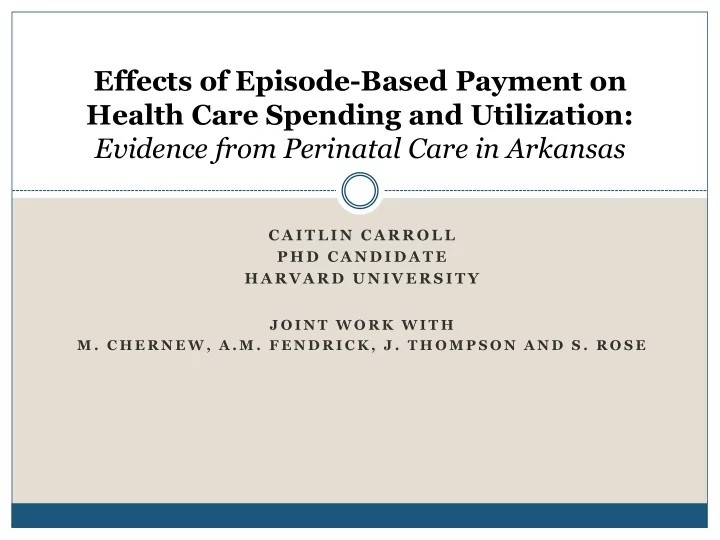

Effects of Episode-Based Payment on Health Care Spending and Utilization: Evidence from Perinatal Care in Arkansas C A I T L I N C A R R O L L P H D C A N D I D A T E H A R V A R D U N I V E R S I T Y J O I N T W O R K W I T H M . C H E R N E W , A . M . F E N D R I C K , J . T H O M P S O N A N D S . R O S E
Background Bundled payment has been proposed as alternative to fee-for-service reimbursement Recently gained traction in multiple markets New payment models use clinical episodes as basis of payment “Episode - based payment” (EBP) Set fee for entire episode of care Incentive to reduce ineffective or duplicative services within episode
Evidence on Episode-Based Payment Voluntary Medicare EBP is associated with lower spending Bundled Payments for Care Improvement (BPCI) Initiative 1 Little research has focused on: Mandatory EBP EBP in the commercial market Arkansas Health Care Payment Improvement Initiative (APII) Collaboration between Arkansas BCBS and Medicaid Automatic participation for providers Applied EBP to perinatal care in 2013 Nearly universal coverage of pregnancies by 2014 1. Navathe et al. (2017); Dummit et al. (2016)
Research Question What was the impact of EBP on the cost and quality of perinatal care in the commercial market in Arkansas?
EBP in Arkansas: FFS with Reconciliation Adapted from Arkansas Payment Improvement Initiative Materials
Perinatal EBP in Arkansas Principal Accountable Provider (PAP) is provider that delivers baby Episode includes all pregnancy related care in episode window Episode exclusions: neonatal care, high risk pregnancies Risk adjustment based on clinical severity PAPs eligible for shared savings if quality targets are satisfied
Research Strategy Data: Truven Health MarketScan Commercial Claims Empirical Strategy: Difference-in-Differences Study period: 2010-2014 Post-EBP: 2013, 2014 Control Group: states in same or neighboring census region with statistically similar pre-period trends Alabama, Kentucky, Louisiana, Oklahoma Control variables: maternal and plan characteristics
Results: Overall Episode Spending
Decomposing EBP’s Spending Effects
Results: Price v. Quantity of Inpatient Facility Care Quantity Measures
Interpretation of Facility Price Decrease Consistent with two broad explanations: Shift in referrals to low-price hospitals Lower negotiated rates for perinatal care Lower negotiated rates would decrease prices for all conditions No evidence of price changes outside of perinatal care Price changes are concentrated in urban areas with multiple hospitals Consistent with a shift in referral patterns
Conclusions and Implications EBP led to an overall reduction in episode spending, relative to surrounding states At 3.8% savings, our results are consistent with other large payment reforms Spending reductions were driven by inpatient facility prices. We found no significant reduction in cesarean section rate. Future work can explore other clinical areas and study provider-level changes
Acknowledgements Funding Laura and John Arnold Foundation NSF Graduate Research Fellowship AHRQ Predoctoral Fellowship
Thank you Email: caitlincarroll@fas.harvard.edu
Recommend
More recommend